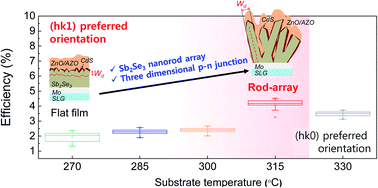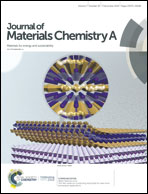Controlled synthesis of (hk1) preferentially oriented Sb2Se3 rod arrays by co-evaporation for photovoltaic applications†
Abstract
In this paper, we propose that the microstructural control of (hk1) preferentially oriented Sb2Se3 films from flat films to rod arrays can improve their photovoltaic efficiency by maximizing the carrier transport characteristics. We found that, during co-evaporation, there is a narrow substrate temperature window where the Sb2Se3 rod array can be formed with an (hk1) preferred orientation, thus maximizing the carrier transport characteristics. The substrate-temperature-dependent morphology of the Sb2Se3 films can be explained by nucleation and growth theory and the terrace-ledge-kink model. Dramatic changes in the (hk0) and (hk1) texture coefficients occur at 315 °C, and the critical temperature for obtaining the (hk1) preferentially oriented Sb2Se3 film is a substrate temperature of 315 °C. On the basis of the observed variation in the film microstructure and texture coefficient, the optimum Sb2Se3 rod array having an (hk1) preferred orientation is formed in a narrow range of substrate temperatures. As a result, we obtained an optimized Sb2Se3 thin-film rod array that shows effective carrier transportation. Further, the optimum fill factor, short circuit current, open circuit voltage, and efficiency of the Sb2Se3 device were observed in the Sb2Se3 rod array having an (hk1) preferred orientation, and the enhanced carrier transport characteristics are the main reason for the improved device properties. These results show that controlling the microstructure of Sb2Se3 allows improvements in the efficiency of (hk1) preferentially oriented Sb2Se3 films.

- This article is part of the themed collection: Research presented at the ICMAT 2019 symposium


 Please wait while we load your content...
Please wait while we load your content...